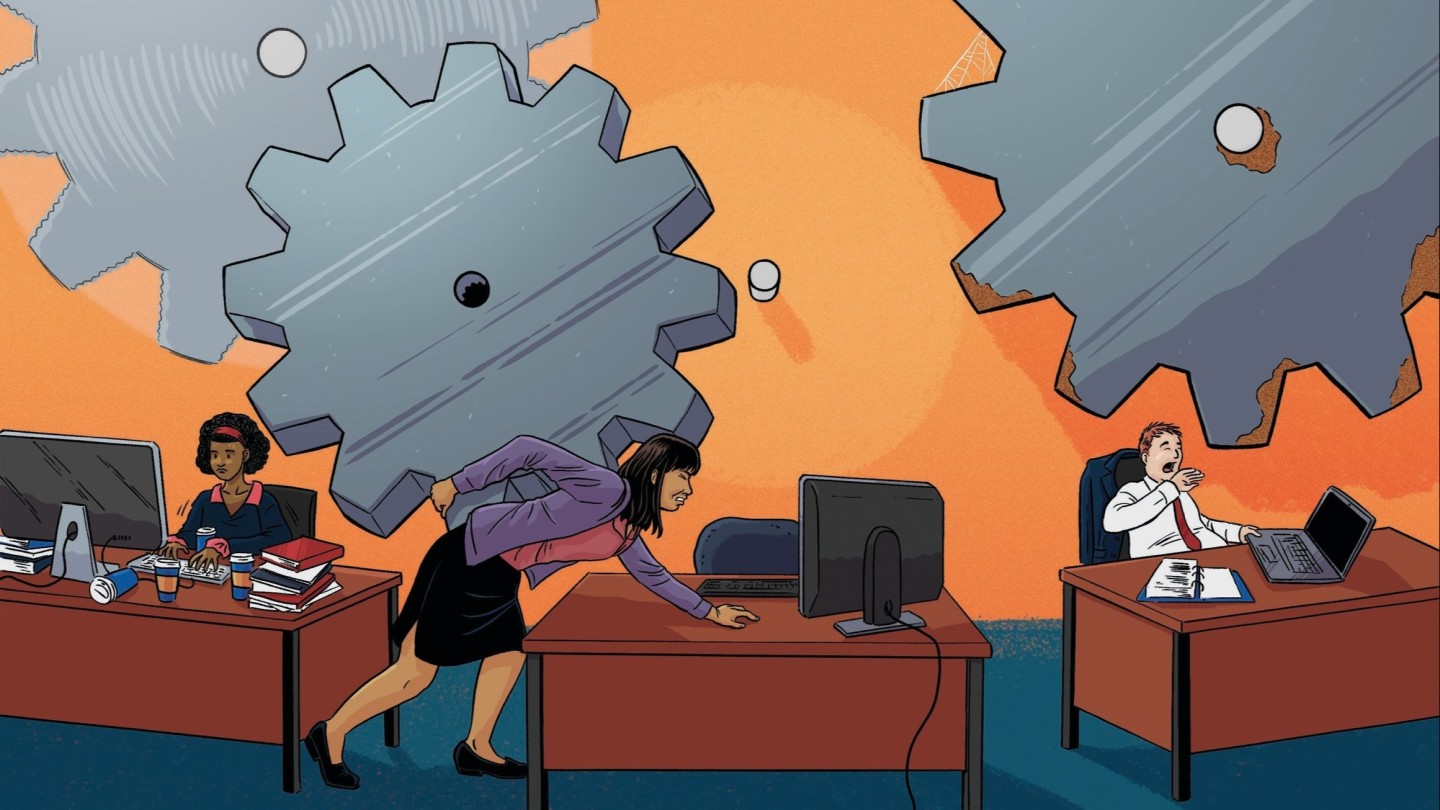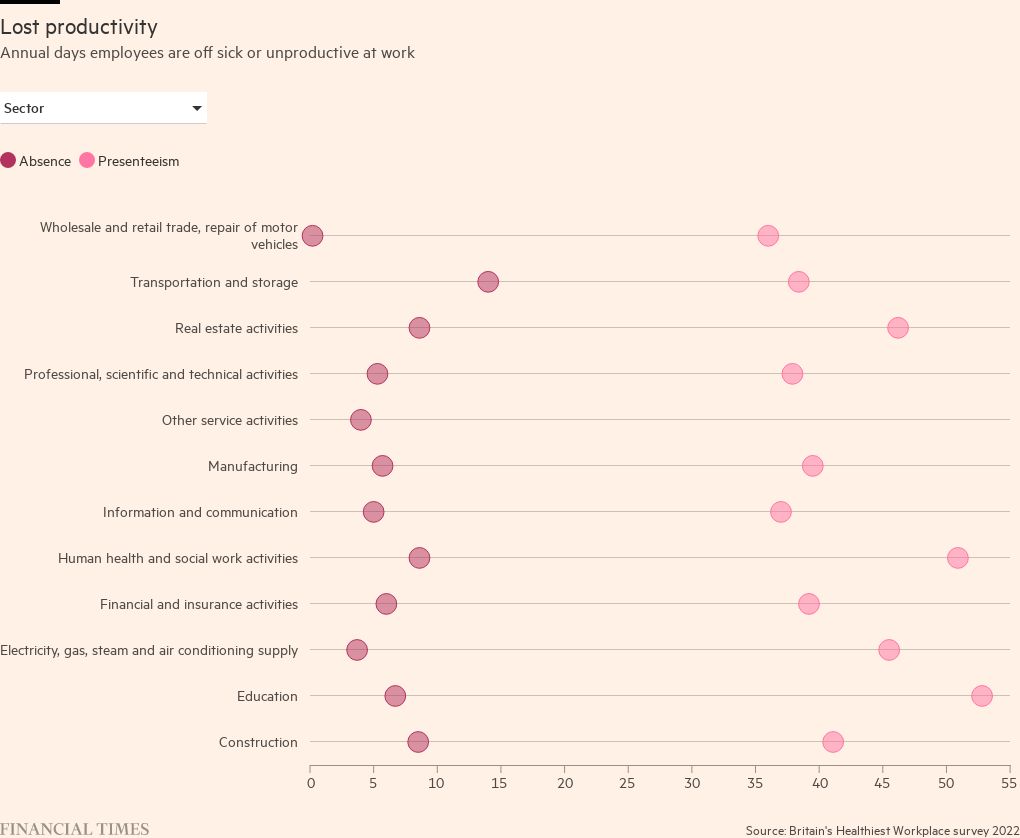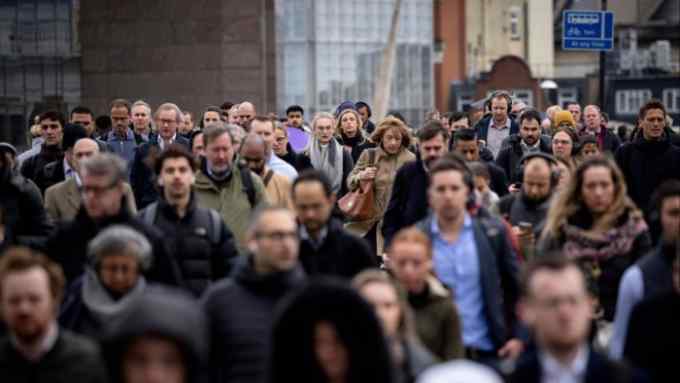Effective initiatives become critical for ailing British workers

Roula Khalaf, Editor of the FT, selects her favourite stories in this weekly newsletter.
If the British workforce were an individual human being, it would be in rather poor health: tired, overweight and depressed, with a poor diet — and unproductive, or off sick, for seven weeks during the past year.
That is the snapshot of the workforce provided by this year’s Britain’s Healthiest Workplace survey, as the nation emerges from two years of pandemic in worse shape. It offers worrying findings for individuals, employers, and the country overall.
The results, based on responses from more than 8,500 workers in 65 private and public sector organisations between March and September this year, offer insights into habits, feelings and practices — with lessons for the health of the nation and the prospects for the economy. The survey and associated awards are funded by Vitality, in partnership with Aon, Rand Europe, Cambridge university and the Financial Times, which jointly help to oversee the analysis.
Most striking is the poor state of employees’ mental health. More than a tenth reported symptoms of depression — double the proportion in the same survey in 2014, and the figure had been steadily rising even before the pandemic. Twenty per cent said they had experienced burnout.
While the individual respondents vary from year to year, the findings are supported by the sample size and similar data. A survey for the charity Business in the Community, by pollster YouGov, showed 36 per cent of employees experienced work-related poor mental health.
This affects employers and the wider economy, as staff prove less productive, with some dropping out of work entirely. “We’re in a situation for the first time, probably, since the industrial revolution, where health and wellbeing are in retreat,” said Andy Haldane, former Bank of England chief economist, in a speech last month. “Having been an accelerator of wellbeing for the last 200 years, health is now serving as a brake in the rise of growth and wellbeing of our citizens.”
Poor sleep and musculoskeletal problems featured in the survey — both are linked with mental ill health and stress. Thirty per cent of respondents said they slept less than seven hours a night, and more than four-fifths reported at least one musculoskeletal condition.
The good news — insofar as cause and effect can be teased out — is that those who were able to work in a hybrid fashion between workplace and home had the lowest overall number of unproductive days, at 47.
People who worked from home believed they had a better work-life balance than other workers and had less burnout — although they also had a higher rate of long Covid symptoms and were less satisfied with their jobs than hybrid workers or those based in offices.
But the reality is that these figures, like others in the survey, vary widely between workers when broken down by factors including employment sector, age, gender, income and region of the UK. Many have little scope to choose their working patterns. People earning more than £120,000 a year reported strikingly fewer days lost to unproductive time, for instance.
Worryingly, productive time lost to sickness or presenteeism — when people are at work but not doing much actual work — was far higher for younger staff (aged below 30), at more than 61 days. These groups reported higher levels of depression, financial insecurity, burnout and job dissatisfaction than their elders. They also drank less alcohol.
Women had higher absence rates than men, and respondents who declared as neither male nor female reported far greater loss of productive days, more problems with sleep, depression and chronic health conditions, more dissatisfaction with their jobs, and a poorer work-life balance.
One surprise was that the level of financial insecurity — a driver of ill-health — was just 10 per cent on average. “Most people came out ahead during the pandemic”, given government support schemes, says Chris van Stolk, executive vice-president at research company Rand Europe and an adviser to Britain’s Healthiest Workplace. But, now that the UK appears to be leaving the worst of the pandemic behind and heading into a period of sluggish growth and austerity, the situation is likely to worsen.
“We know this next period will be even tougher. It’s a burning platform,” van Stolk says.
Some 78 per cent of respondents said their manager cared about the health and wellbeing of staff, but just a third believed their employer should play a more active role in helping them to maintain their health and wellbeing.
Many employers reported that they offer interventions on diet, physical activity, mental health, financial wellbeing, alcohol, smoking and sleep. Yet, setting aside mental ill health and days lost to work, physical wellbeing remains poor: nearly two-fifths said they were physically inactive, meaning they spent less than 150 minutes a week doing physical activity. More than half do not eat at least five portions of fruit or vegetables a day, and a quarter are obese (with a body mass index higher than 30).
One issue is how far line managers are sufficiently empowered to respond to the needs of their staff. Another is the level of awareness, use and effectiveness of the interventions offered. The survey showed that between a quarter and a half of workers were unaware of programmes on offer from their employers; and the proportion of staff who used them and found them to be effective varied widely.
The reality is that evidence for specific interventions remains limited. Prof Dame Carol Black, a physician and health adviser to government, and chair of Britain’s Healthiest Workplace, argues that the data point to a continued failure, despite growing activities in the workplace. “It tells us the interventions we thought would be helpful have not delivered,” she says.
The challenge for public health specialists and employers alike during a tougher period ahead is how to better identify, test and implement interventions that demonstrably improve physical and mental wellbeing in the workplace.
Without further such efforts, the health of employees will continue to exert an ever greater drag on their organisations.


Comments